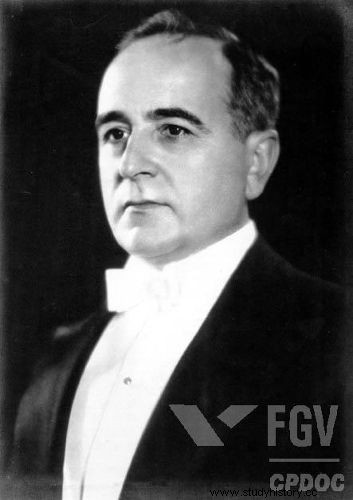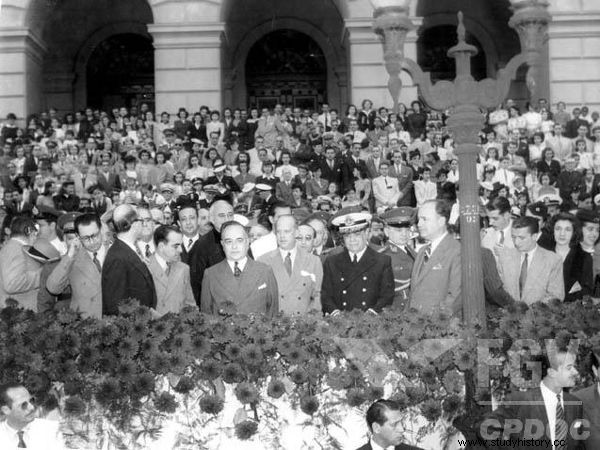
The New State it was the dictatorial phase of the government of Getúlio Vargas. In all, Vargas remained in power from 1930 to 1945, but the Estado Novo phase corresponds specifically to the period from 1937 to 1945. It began in November 1937, when the Estado Novo coup was carried out. and ended when the military forced Vargas to withdraw from power.
How did the New State start?
The emergence of the Estado Novo in 1937 was the result of a long effort by Getúlio Vargas to build an authoritarian regime in Brazil. It is important to consider that, since assuming the presidency in November 1930, Vargas has taken initiatives to centralize power. An obvious demonstration of this was Vargas' action in postponing as long as possible the holding of elections to form a Constituent in Brazil.
Also see: Learn about the war that the paulistas started against Vargas
Getúlio Vargas' efforts to centralize power in Brazil were partially frustrated with the enactment of the Constitution of 1934, which determined that new elections should be held in 1938 and that Vargas could not run for reelection, as he had been indirectly elected president in 1934.
However, in this phase of the Vargas Era, known as the “constitutional phase”, the president found the justification he needed to implement centralizing measures, which put Brazil on the path of authoritarianism. Vargas used the “communist threat” as a way of increasing his power in the presidency.
In 1935, the Intentona Communist , an attempt by the communists to seize power in Brazil through the revolutionary path. Before that, in fact, the president already supported authoritarian measures, which were expanded after the communist rebellion. In 1935, the Law was enacted from Security National, which expanded presidential powers to combat crimes against the “social order”.
Shortly later, this law was strengthened by an amendment approved by Brazilian parliamentarians. A National Security Court was also created , used to rigorously punish the defendants of the law passed in 1935. In this scenario, the persecution of leftist groups has considerably expanded.
While all this was happening, the Army began to align its interests with those of Getúlio Vargas in the sense of persecuting leftist groups and implementing an authoritarian regime in the country. High-ranking parts of society also began to understand the authoritarian bias as the ideal way to forcibly implement a modernization of the country.
The end result of this process led to the Coup do Estado Novo in November 1937. The coup took place shortly after the government published a false document called the Cohen Plan . This plan narrated the stages of a communist coup that was being planned. The document, however, had been prepared by Olímpio Mourão and by the integralists.
The document containing the Cohen Plan was discovered by the former Minister of War, Góes Monteiro, and it was presented to Vargas and Eurico Gaspar Dutra, who approved the use of the false document as a pretext for carrying out the coup in Brazil. From there, Francis Fields , a lawyer from Minas Gerais, began to organize a new Constitution for Brazil.
In November 1937, Vargas ordered the encirclement of the National Congress and forced the parliamentarians to return to their homes. Immediately, a new Constitution was presented and granted to the nation. Vargas decreed the end of the activities of political parties in the country.
New State Features

Getúlio Vargas and other representatives of the Estado Novo during an event held in Rio de Janeiro, in 1943.**
The implementation of the Estado Novo in Brazil followed the global trend of political radicalization. In the 1930s, a series of totalitarian regimes emerged or consolidated in different parts of the world, such as Stalinism Soviet , Nazism in Germany, Fascism in Italy, Francism in Spain and Salazarism in Portugal.
Also see: Discover the conflict responsible for Franco's rise to power in Spain
In Brazil, an authoritarian regime was consolidated which, according to historian Thomas Skidmore, was a personal creation of Vargas himself and which, therefore, has peculiarities that may be slightly different from the characteristics of the dictatorial regimes that existed in other parts of the world at the time |1| .
An initial feature of the Estado Novo was the strengthening of the Executive , as a series of prerogatives that were in the hands of states and municipalities passed to the federal level. Another important point was that the Executive accumulated the functions of the Legislative, since the National Congress, State Assemblies and Municipal Chambers were closed. This also happened in relation to the “interventors”, the name given to state governors. The strengthening of the interventors was, in fact, an important device to support Vargas' power in the regional spheres.
During the Estado Novo, the president always reinforced the valuation of nationalism , named in his government as “Brazilianness”. This characteristic was reinforced in government actions such as the “March to the West”, a housing and development movement in the interior of the country as a way of rescuing real national values.
Another symbol of Vargas' quest to reinforce nationalism in Brazil was an act in which the president organized the burning of state flags shortly after the 1937 coup. the power of the Executive and of exalting nationalism, fighting regionalisms, had the practical effect of weakening the oligarchies.
In politics, Vargas fighted the party system (which was seen by the president as an evil). Vargas even never formed a single party that represented his own government, as happened in the authoritarian and fascist regimes of Europe. In this regard, Thomas Skidmore states that “the 'non-political' system of the Estado Novo was the perfect vehicle for its great talents of conciliation and manipulation, which in turn depended on an extremely personal contact with adversaries and allies” strong>|2| .
In addition, censorship and the advertisement policy were important parts of the Estado Novo. The two questions were the responsibility of the Department of Press and Propaganda (DIP), an agency created by the government in 1939. Regarding the DIP, historians Lilia Schwarcz and Heloisa Starling state:
Directly subordinated to the government [the DIP], with agencies affiliated to the states and directed by a journalist, Lourival Fontes, […], the DIP was a machine well planned:it had six sections – advertising, broadcasting, cinema and theater, tourism, press and auxiliary services – and the task of designing the bases of legitimacy for the Estado Novo. The agency interfered in all areas of Brazilian culture:it censored forms of artistic and cultural expression; instrumentalized composers, journalists, writers and artists, and developed multiple lines of action. |3|
The use of intellectuals and artists was extremely important for the Estado Novo, as Vargas knew that their opinion was extremely important to legitimize the actions that the government carried out and make them acceptable in the lowest strata of society. Another important point of the Estado Novo was the exaltation of the figure of the leader from the advertisement.
Thomas Skidmore, however, claims that Vargas was not very supportive of the personality cult that was carried out by the DIP, but approved of it as long as it proved effective in securing support for his regime |4| .
End of New Status
The Estado Novo, as a regime that supported itself in intellectual circles, economic elites and military circles, began to collapse around 1943. A clear sign of this was the publication of the “ manifest dos miners ”, in which personalities from Minas Gerais demanded the installation of a democratic regime in the country.
During this period, Vargas identified that his authoritarian regime would not have a long life after the end of the Second World War. Thus, Vargas began a new phase of his policy:the phase of approaching the workers . He had already flirted with this stance in previous years. This can be exemplified by the decree of the minimum wage in 1940 and for organizing Labor Day rallies. From 1943 onwards, Vargas strengthened this approach.
This year, for example, the Consolidation of Labor Laws , a document that brought a series of novelties in labor legislation, expanding the rights of urban workers (the legislation did not extend to rural workers). This new phase of Vargas was called trabalhismo and aimed to guarantee its influence in Brazilian politics once the democratic system was re-established.
From 1945 onwards, pressure on Vargas for a presidential election to take place was such that Vargas enacted the Act Additional . With this law, the government decreed that within a period of 90 days the date for the presidential election would be set. After that, a new party life began to be organized in the country, with emphasis on three parties.
-
National Democratic Union (UDN);
-
Social Democratic Party (PSD);
-
Brazilian Labor Party (PTB).
To learn more about the parties that formed at the end of the Estado Novo, access this text about the Fourth Republic.
During 1945, Vargas' attrition towards the liberals and the military increased to such an extent that, in October 1945, the military surrounded the presidential palace and gave an ultimatum to Vargas, forcing him to resign to the presidency of Brazil. The political reorganization of Brazil from that moment gave rise to the Fourth Republic (1946-1964).
Summary
The Estado Novo was the dictatorial phase of the Vargas Era. It began in November 1937, when the president granted a new Constitution and decreed the closure of Congress, and ended when Vargas received an ultimatum from the military and was forced to resign from the presidency, in October 1945.
With the Estado Novo, Vargas implemented an authoritarian regime which centralized power in the Executive. Censorship was instituted, and political propaganda was used on a large scale as a tool to highlight the government's works, consolidate the regime's ideology and guarantee the cult of Vargas' personality.
With Brazil's involvement in World War II, Vargas' authoritarianism lost strength, especially among the military who had been sent to Europe to fight nazifascimo . With this movement of contestation, Vargas' authority was being undermined, which led to his dismissal. Vargas, however, reorganized his political strategy and began his policy of approaching the masses.
|1| SKIDMORE, Thomas E. Brazil:from Getúlio to Castello (1930-64). São Paulo:Companhia das Letras, 2010, p. 64.
|2| Ditto, p. 71.
|3| SCHWARCZ, Lilia Moritz and STARLING, Heloísa Murgel. Brazil:A Biography. São Paulo:Companhia das Letras, 2015, p. 376.
|4| SKIDMORE, Thomas E. Brazil:from Getúlio to Castello (1930-64). São Paulo:Companhia das Letras, 2010, p. 70.
*Image credits:FGV/CPDOC
**Image Credits:FGV/CPDOC
Take the opportunity to check out our video lesson on the subject:
